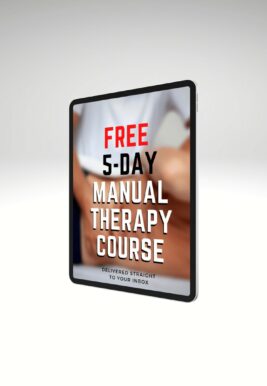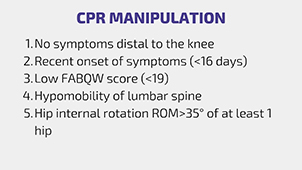Learn
Lumbar Manipulation CPR | Clinical Predication Rule by Flynn
The big group of patients with low back pain is very heterogeneous. Therefore, it has been suggested that effective subgrouping based on treatment success is an option for more effective management.
The clinical prediction rule of Flynn et al. (2002) is a tool designed to assist your classification process and to use evidence to determine which patients are likely to benefit from lumbar manipulation. This CPR has been validated by Childs et al. in the year 2004, showing that in this particular group, manipulation + exercises are more successful in reducing pain and disability compared to exercises alone.
So let´s look at the 5 different criteria that are described by the author to predict success with manipulation:
1) No symptoms distal to the knee. This makes sense as symptoms distal to the knee are often related to lumbosacral radicular syndrome in which case there is conflicting evidence about manipulation. This group was also excluded in the study of Flynn et al.
2) Recent onset of symptoms, meaning less than 16 days. The reason is that in the subchronic or chronic group often psychosocial factors are present, so not only impairments on tissue level will have a big contribution to the maintenance of pain.
3) Low FABQW score (<19). So all questions in the scale that are related to work had to be less than a score of 19. So the more work is perceived as a contributing factor to pain, the less success was achieved with lumbar manipulation. Also more of an environmental factor than
4) Hypomobility of the lumbar spine, which makes sense as one of your goals with manipulation is to increase the range of motion.
5) Hip internal rotation ROM (>35° for at least 1 hip). In patients with decreased hip mobility, we are talking about the so-called hip-spine dilemma. So in this group, it´s rather the hip that should be mobilized, so that their thoracolumbar area doesn´t have to compensate.
If 3 or more of those 5 items were present, the likelihood of success with manipulation increased by a factor of 2.61. With 4 or more items, the chance for success increased by a factor of 24.38 and with all of these items positive, the chances for success increased indefinitely!
If your patient has 2 or fewer of these items, you will have to think of a different treatment approach. Your patient might rather fall into the stabilization category.
5 ESSENTIAL MOBILIZATION / MANIPULATION TECHNIQUES EVERY PHYSIO SHOULD MASTER

If you are curious about another clinical prediction rule in the spine, check out the following post:
References
Like what you’re learning?
BUY THE FULL PHYSIOTUTORS ASSESSMENT BOOK
- 600+ Pages e-Book
- Interactive Content (Direct Video Demonstration, PubMed articles)
- Statistical Values for all Special Tests from the latest research
- Available in 🇬🇧 🇩🇪 🇫🇷 🇪🇸 🇮🇹 🇵🇹 🇹🇷
- And much more!








